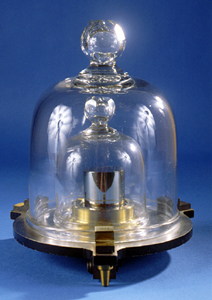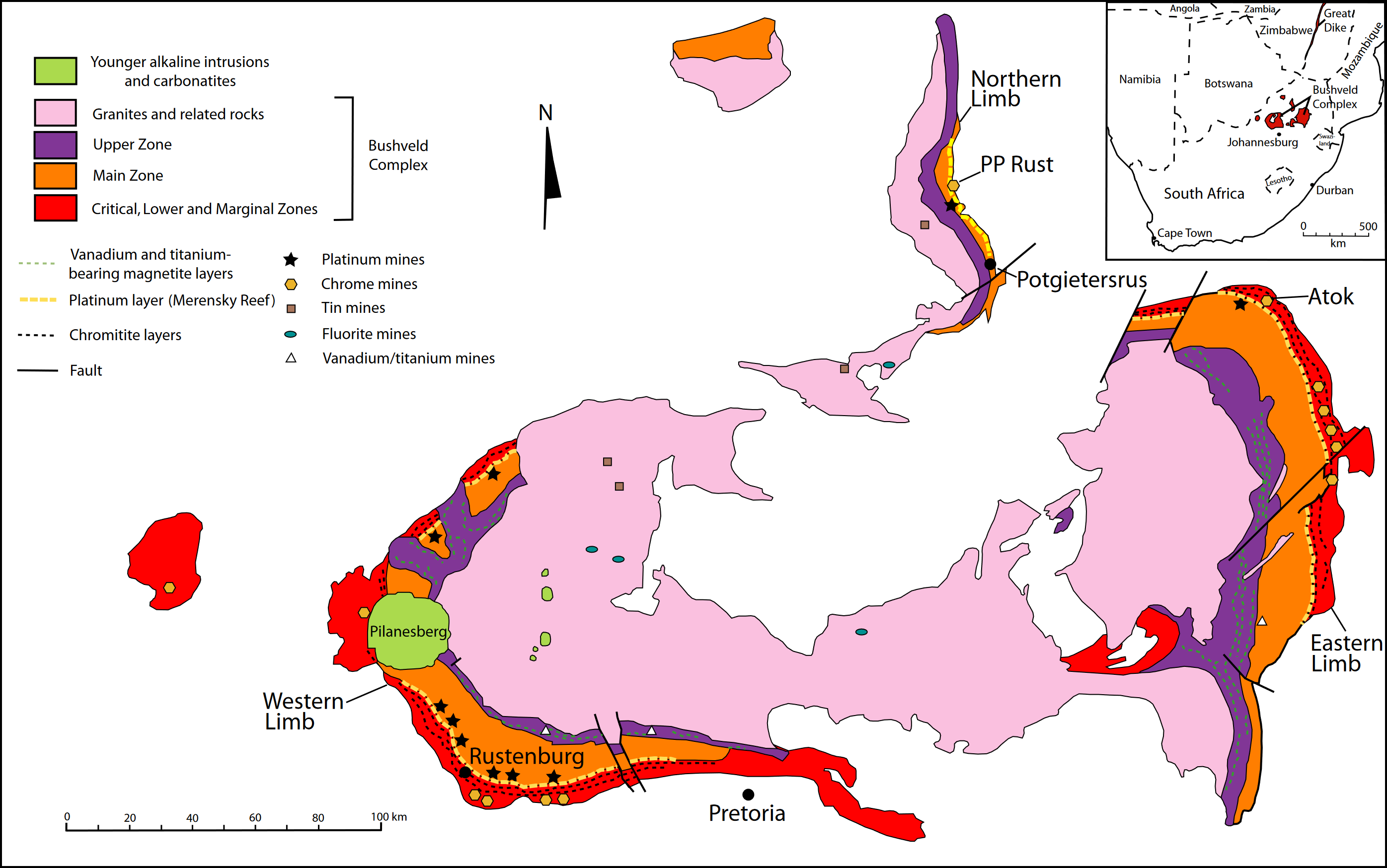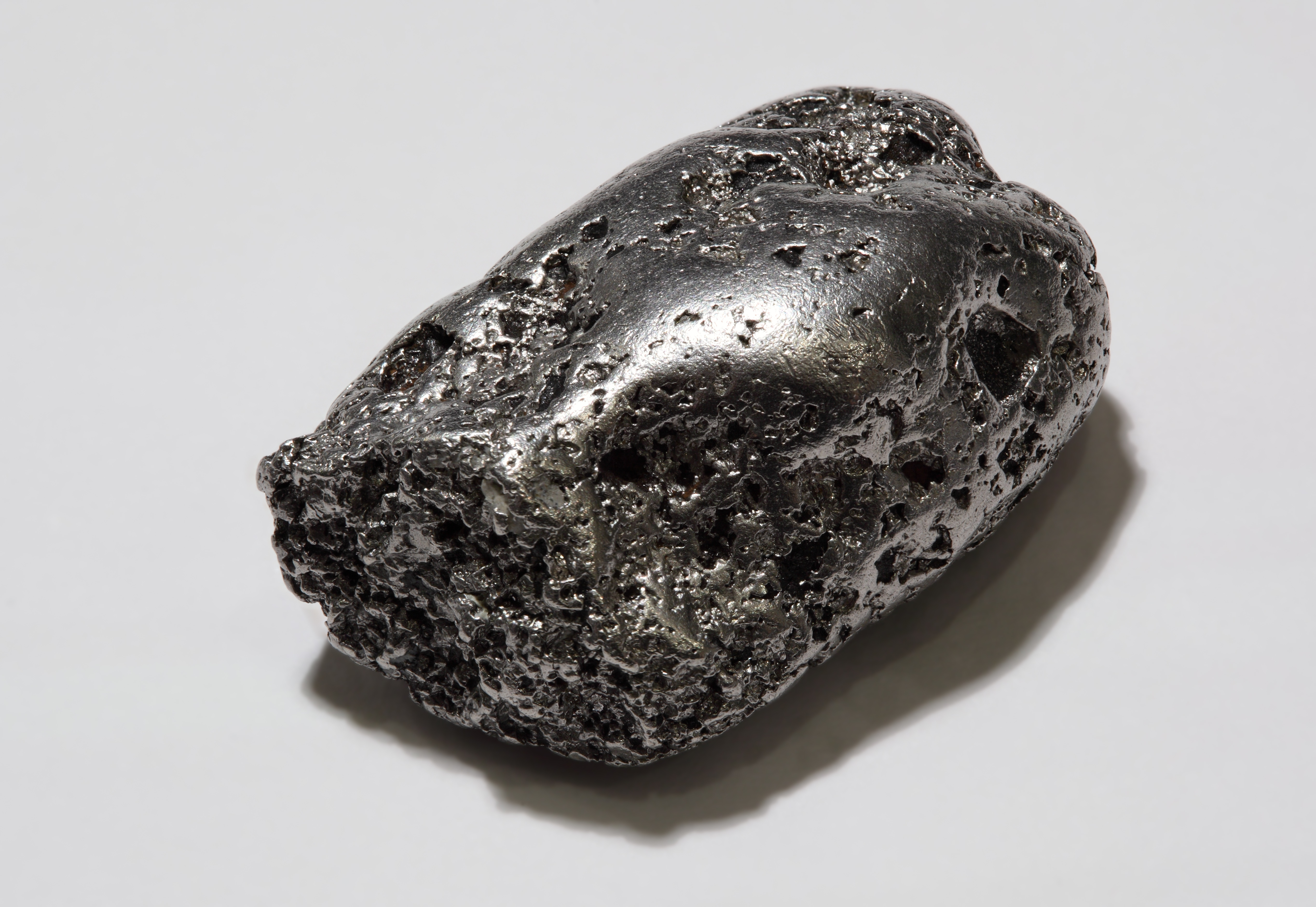|
Palladium
Palladium is a chemical element; it has symbol Pd and atomic number 46. It is a rare and lustrous silvery-white metal discovered in 1802 by the English chemist William Hyde Wollaston. He named it after the asteroid Pallas (formally 2 Pallas), which was itself named after the epithet of the Greek goddess Athena, acquired by her when she slew Pallas. Palladium, platinum, rhodium, ruthenium, iridium and osmium form together a group of elements referred to as the platinum group metals (PGMs). They have similar chemical properties, but palladium has the lowest melting point and is the least dense of them. More than half the supply of palladium and its congener platinum is used in catalytic converters, which convert as much as 90% of the harmful gases in automobile exhaust (hydrocarbons, carbon monoxide, and nitrogen dioxide) into nontoxic substances (nitrogen, carbon dioxide and water vapor). Palladium is also used in electronics, dentistry, medicine, hydrogen purification ... [...More Info...] [...Related Items...] OR: [Wikipedia] [Google] [Baidu] |
Platinum Group
The platinum-group metals (PGMs) are six noble, precious metallic elements clustered together in the periodic table. These elements are all transition metals in the d-block (groups 8, 9, and 10, periods 5 and 6). The six platinum-group metals are ruthenium, rhodium, palladium, osmium, iridium, and platinum. They have similar physical and chemical properties, and tend to occur together in the same mineral deposits. However, they can be further subdivided into the ''iridium-group platinum-group elements'' (IPGEs: Os, Ir, Ru) and the ''palladium-group platinum-group elements'' (PPGEs: Rh, Pt, Pd) based on their behaviour in geological systems. The three elements above the platinum group in the periodic table (iron, nickel and cobalt) are all ferromagnetic; these, together with the lanthanide element gadolinium (at temperatures below 20 °C), are the only known transition metals that display ferromagnetism near room temperature. History Naturally occurring plati ... [...More Info...] [...Related Items...] OR: [Wikipedia] [Google] [Baidu] |
William Hyde Wollaston
William Hyde Wollaston (; 6 August 1766 – 22 December 1828) was an English chemist and physicist who is famous for discovering the chemical elements palladium and rhodium. He also developed a way to process platinum ore into malleable ingots,Melvyn C. UsselmanWilliam Hyde WollastonEncyclopædia Britannica, retrieved 31 March 2013 patented the camera lucida, and made contributions in electricity and spectroscopy. Life He was born in East Dereham in Norfolk, the son of the Francis Wollaston (1737–1815), a noted amateur astronomer, and his wife Althea Hyde. He was one of 17 children, but the family was financially well-off and he enjoyed an intellectually stimulating environment. He was educated privately (and remotely) at Charterhouse School from 1774 to 1778 then studied Sciences at Gonville and Caius College, Cambridge. In 1793 he obtained his doctorate (MD) in medicine from Cambridge University, and was a Fellow of his college from 1787 to 1828. He worked as a ph ... [...More Info...] [...Related Items...] OR: [Wikipedia] [Google] [Baidu] |
Athena
Athena or Athene, often given the epithet Pallas, is an ancient Greek religion, ancient Greek goddess associated with wisdom, warfare, and handicraft who was later syncretism, syncretized with the Roman goddess Minerva. Athena was regarded as the patron and protectress of various cities across Greece, particularly the city of Athens, from which she most likely received her name. The Parthenon on the Acropolis of Athens is dedicated to her. Her major symbols include Owl of Athena, owls, olive trees, snakes, and the Gorgoneion. In art, she is generally depicted wearing a helmet and holding a spear. From her origin as an Aegean tutelary deity, palace goddess, Athena was closely associated with the city. She was known as ''Polias'' and ''Poliouchos'' (both derived from ''polis'', meaning "city-state"), and her temples were usually located atop the fortified acropolis in the central part of the city. The Parthenon on the Athenian Acropolis is dedicated to her, along with numero ... [...More Info...] [...Related Items...] OR: [Wikipedia] [Google] [Baidu] |
Symbol (chemistry)
Chemical symbols are the abbreviations used in chemistry, mainly for chemical elements; but also for functional groups, chemical compounds, and other entities. Element symbols for chemical elements, also known as atomic symbols, normally consist of one or two letters from the Latin alphabet and are written with the first letter capitalised. History Earlier symbols for chemical elements stem from classical Latin and Greek words. For some elements, this is because the material was known in ancient times, while for others, the name is a more recent invention. For example, Pb is the symbol for lead (''plumbum'' in Latin); Hg is the symbol for mercury (''hydrargyrum'' in Greek); and He is the symbol for helium (a Neo-Latin name) because helium was not known in ancient Roman times. Some symbols come from other sources, like W for tungsten (''Wolfram'' in German) which was not known in Roman times. A three-letter temporary symbol may be assigned to a newly synthesized (or not yet ... [...More Info...] [...Related Items...] OR: [Wikipedia] [Google] [Baidu] |
Bushveld Igneous Complex
The Bushveld Igneous Complex (BIC) is the largest Layered intrusion, layered igneous intrusion within the Earth's Crust (geology), crust. It has been tilted and Erosion, eroded forming the outcrops around what appears to be the edge of a great Basin (geology), geological basin: the Transvaal Basin. It is approximately two billion years old and is divided into four limbs or lobes: northern, eastern, southern and western. It comprises the Rustenburg Layered suite, the Lebowa Granites and the Rooiberg Felsics, that are overlain by the Karoo sediments. The site was first publicised around 1897 by Gustaaf Molengraaff who found the native South African tribes residing in and around the area. Located in South Africa, the BIC contains some of the richest ore deposits on Earth. It contains the world's largest reserves of platinum-group metals (PGMs) and Platinum group, platinum group elements (PGEs) — platinum, palladium, osmium, iridium, rhodium and ruthenium — along with vast quantit ... [...More Info...] [...Related Items...] OR: [Wikipedia] [Google] [Baidu] |
Rhodium
Rhodium is a chemical element; it has symbol Rh and atomic number 45. It is a very rare, silvery-white, hard, corrosion-resistant transition metal. It is a noble metal and a member of the platinum group. It has only one naturally occurring isotope, which is 103Rh. Naturally occurring rhodium is usually found as a free metal or as an alloy with similar metals and rarely as a chemical compound in minerals such as bowieite and rhodplumsite. It is one of the rarest and most valuable precious metals. Rhodium is a group 9 element (cobalt group). Rhodium is found in platinum or nickel ores with the other members of the platinum group metals. It was discovered in 1803 by William Hyde Wollaston in one such ore, and named for the rose color of one of its chlorine compounds. The element's major use (consuming about 80% of world rhodium production) is as one of the catalysts in the three-way catalytic converters in automobiles. Because rhodium metal is inert against corrosion and mos ... [...More Info...] [...Related Items...] OR: [Wikipedia] [Google] [Baidu] |
Catalytic Converter
A catalytic converter part is an vehicle emissions control, exhaust emission control device which converts toxic gases and pollutants in exhaust gas from an internal combustion engine into less-toxic pollutants by catalysis, catalyzing a redox chemical reaction, reaction. Catalytic converters are usually used with internal combustion engines fueled by gasoline or diesel fuel, diesel, including lean-burn engines, and sometimes on kerosene heaters and stoves. The first widespread introduction of catalytic converters was in the United States automobile market. To comply with the United States Environmental Protection Agency, U.S. Environmental Protection Agency's stricter regulation of exhaust emissions, most gasoline-powered vehicles starting with the 1975 model year are equipped with catalytic converters. These "two-way" oxidation converters combine oxygen with carbon monoxide (CO) and unburned hydrocarbons (HC) to produce carbon dioxide (CO2) and water (H2O). "Three-way" conve ... [...More Info...] [...Related Items...] OR: [Wikipedia] [Google] [Baidu] |
Hydrogen Purification
Hydrogen purification is any technology used to purify hydrogen. The impurities in hydrogen gas depend on the source of the H2, e.g., petroleum, coal, electrolysis, etc. The required purity is determined by the application of the hydrogen gas. For example, ultra-high purified hydrogen is needed for applications like proton exchange membrane fuel cells. Purification technologies Low temperature methods The default large-scale purification of H2 produced in oil refineries exploits its very low boiling point of −253 °C. Most impurities have boiling points well above this temperature. Low temperature methods can be complemented by scrubbing to remove particular impurities. Palladium membrane hydrogen purifiers Hydrogen can be purified by passing through a membrane composed of palladium and silver. Permeability of the former to hydrogen was discovered back in the 1860s. An alloy with a ca. 3:1 ratio for Pd:Ag is more structural robust than pure Pd, which is the active compo ... [...More Info...] [...Related Items...] OR: [Wikipedia] [Google] [Baidu] |
Asteroid Pallas
Pallas ( minor-planet designation: 2 Pallas) is the third-largest asteroid in the Solar System by volume and mass. It is the second asteroid to have been discovered, after Ceres, and is likely a remnant protoplanet. Like Ceres, it is believed to have a mineral composition similar to carbonaceous chondrite meteorites, though significantly less hydrated than Ceres. It is 79% the mass of Vesta and 22% the mass of Ceres, constituting an estimated 7% of the total mass of the asteroid belt. Its estimated volume is equivalent to a sphere in diameter, 90–95% the volume of Vesta. During the planetary formation era of the Solar System, objects grew in size through an accretion process to approximately the size of Pallas. Most of these protoplanets were incorporated into the growth of larger bodies, which became the planets, whereas others were ejected by the planets or destroyed in collisions with each other. Pallas, Vesta and Ceres appear to be the only intact bodies from t ... [...More Info...] [...Related Items...] OR: [Wikipedia] [Google] [Baidu] |
Pallas (daughter Of Triton)
In Greek mythology, Pallas (; ) was a sea nymph and a warrior. Mythology Pallas was the daughter of Triton, a son of Poseidon and the messenger of the seas. After Athena was born fully armed from Zeus' forehead, Triton became foster parent to the goddess and raised her alongside Pallas. After he taught both girls the arts of war, the two became very close friends. During an athletics festival, Pallas and Athena fought with spears in a friendly mock battle in which the victor would be whoever managed to disarm her opponent. At the beginning of the fight, Athena got the upper hand, until Pallas took over. Before she could win, Zeus, who was in attendance, fearing to see his own daughter lose, distracted Pallas with the Aegis, which she had once shown interest in. Pallas, stunned in awe, stood still as Athena, expecting her to dodge, impaled her accidentally. Out of sadness and regret, Athena created the palladium, a statue in the likeness of Pallas, and wrapped the aegis, whic ... [...More Info...] [...Related Items...] OR: [Wikipedia] [Google] [Baidu] |
Platinum
Platinum is a chemical element; it has Symbol (chemistry), symbol Pt and atomic number 78. It is a density, dense, malleable, ductility, ductile, highly unreactive, precious metal, precious, silverish-white transition metal. Its name originates from Spanish language, Spanish , a diminutive of "silver". Platinum is a member of the platinum group of elements and group 10 element, group 10 of the periodic table of elements. It has six naturally occurring isotopes. It is one of the Abundance of elements in Earth's crust, rarer elements in Earth's crust, with an average abundance of approximately 5 microgram, μg/kg, making platinum about 30 times rarer than gold. It occurs in some nickel and copper ores along with some Native element mineral, native deposits, with 90% of current production from deposits across Russia's Ural Mountains, Colombia, the Sudbury Basin, Sudbury basin of Canada, and a large reserve in South Africa. Because of its scarcity in Earth's crust, only a f ... [...More Info...] [...Related Items...] OR: [Wikipedia] [Google] [Baidu] |
Osmium
Osmium () is a chemical element; it has Symbol (chemistry), symbol Os and atomic number 76. It is a hard, brittle, bluish-white transition metal in the platinum group that is found as a Abundance of elements in Earth's crust, trace element in alloys, mostly in platinum ores. Osmium is the densest naturally occurring element. When experimentally measured using X-ray crystallography, it has a density of . Manufacturers use its alloys with platinum, iridium, and other platinum-group metals to make fountain pen Nib (pen)#Nib tipping, nib tipping, electrical contacts, and in other applications that require extreme durability and hardness. Osmium is among the Abundance of elements in Earth's crust, rarest elements in the Earth's crust, making up only 50 parts per trillion (Parts-per notation#Parts-per expressions, ppt). Characteristics Physical properties Osmium is a hard, brittle, blue-gray metal, and the densest stable element—about twice as dense as lead. The density of os ... [...More Info...] [...Related Items...] OR: [Wikipedia] [Google] [Baidu] |







